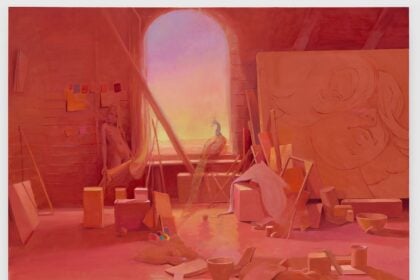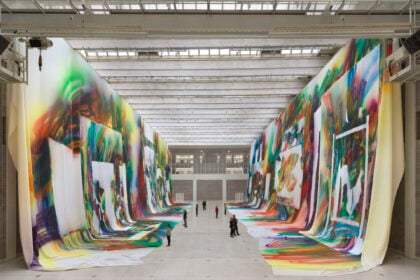
Zen Painting 1970 禪畫 1970, 1970
Ink and color on rice paper
151.5 x 82.5 cm
NEW YORK, NY — Alisan Fine Arts is delighted to announce Shifting Landscapes, a solo exhibition celebrating the art of pioneering ink artist Lui Shou-Kwan (1919-1975). Shifting Landscapes, Lui’s first exhibition in New York, presents transformative works from the artist’s career that bridge tradition and modernity while sparking new dialogue in the international art community. Lui was a vanguard figure of the New Ink Movement in Hong Kong, a movement that reimagined the Chinese Ink tradition and flourished from the 1950s to 1970s. Extremely influential to generations of artists after him, Lui was instrumental in transforming traditional Chinese ink painting into a modern, global art form. Surveying three decades, Shifting Landscapes will run from February 27 to April 27, 2024, at Alisan Fine Arts’ recently opened New York gallery. The opening reception is Tuesday, February 27 from 6 to 8 p.m. at 120 E 65th St, New York, NY 10065.
Lui inherited his interest in painting from his father, Lui Canming (1892-1963), a scholar-painter and antique shop owner. Prior to a decisive move to Hong Kong in 1948, Lui studied Chinese painting by copying classical works by past masters, such as Bada Shanren (1626-1705, Ming Dynasty), Shitao (1642-1707, Qing Dynasty) and Huang Binhong (1865-1955).
Throughout his time in Hong Kong—then under British Colonial rule—Lui was exposed to Western modern art, including Abstract Expressionism. These influences catalyzed a pivotal shift in Lui’s philosophy of art; he came to believe that true artistry lay not in imitation, but in personal expression and the development of a distinctive artistic voice. Lui’s landscape works were inspired by Hong Kong’s mountains and harbors, which he observed during his time working as an inspector in 1948 for the Hong Kong and Yaumatei Ferry Company. As his work matured, two distinct styles developed: one traditional and the other more modern. After the Visit to Tai Po Kau (1966) and Lu Keng (1969) are examples of his traditional landscapes, the latter of which he used as a teaching aid. At the same time, his new philosophy presented itself in landscape works which became increasingly abstract, with boats, houses and seaside cliffs reduced to simple, expressive brushstrokes. Red Mountain Landscape (1962) is a striking example of this, where broad swathes of ink and color reveal themselves to be mountains only after the viewer notices the small painted boats in the foreground.

The Reveal of the Inner Pond 塘裏所露端倪, 1969
Ink and color on rice paper
147 x 80 cm
Lui began to shift toward abstraction as early as the 1950s, influenced by his encounter with Sam Hunter’s book “Modern American Painting and Sculpture,” paying particular attention to artists like Willem de Kooning, Adolph Gottlieb, Mark Rothko, Philip Guston, Robert Motherwell, Franz Kline, Arshile Gorky and Jackson Pollock. As he continued to embrace modernism as a pursuit of individual expression and freedom, Lui profoundly explored pure abstraction in his new Zen paintings.
Influenced by Buddhist meditation and Daoist philosophy, Liu’s Zen paintings are less about the abstraction of the natural world and more a representation of spiritual concepts and mental states, replete with ink splashes and geometric shapes. While created in parallel to that of his American contemporaries, Lui’s art diverges in its introspective journey, symbolized by the lotus in his Zen paintings—a growth from murky waters to spiritual enlightenment. Zen Painting 1965 Winter (1965) and The Reveal of the Inner Pond (1969) both feature Lui’s signature red ‘lotus’, a visual metaphor for a state of mind that is untainted by the external world and reflective from within, embodying the essence of his artistic and spiritual quest.
By the 1970s, Lui’s pioneering visual language had galvanized an international recognition of the Chinese ink painting tradition and brought contemporary interpretations to the forefront of the art world. His influence was pivotal to the New Ink movement, by then an international movement exploring thousand-year-old techniques alongside the developments and inspiration of expressionistic and conceptual art. As a revered educator and prominent figure in the New Ink movement and to other artists working in Hong Kong, Lui shaped a generation of artists who carried forward the torch of innovation he lit.

After the Visit to Tai Po Kau 遊大埔滘後, 1966
Ink and color on rice paper
42 x 58 cm
Coinciding with Asia Week in March, Shifting Landscapes will be presented in conversation with Landscape as Metaphor: Contemporary Voices, a group exhibition of works by contemporary artists in Alisan Fine Arts’ adjacent gallery. Artists Bouie Choi, Chu Chu, Lam Tung Pang, Kelly Wang and Yang Yongliang each distinctively interpret the subject of landscape. Bouie Choi uses reclaimed wood, allowing inconsistencies and unexpected textures in the wood to inform compositions that depict the urban scenery of Hong Kong; Chu Chu uses photography as a backdrop to her flowing, effervescent calligraphy; Lam Tung Pang’s recent landscapes on wood panel are a reflection on his relocation in 2022 from Hong Kong to Vancouver; Kelly Wang creates otherworldly scenes that hover on the edge of abstraction, using rolled newsprint and mixed media; and Yang Yongliang creates fictional landscapes in a traditional Chinese style using recomposed photographs of contemporary urban images. Landscape as Metaphor: Contemporary Voices will run from February 27-April 27.
About Lui Shou-Kwan
Lui Shou-Kwan (1919–1975, Guangzhou China), recognized as Hong Kong’s pioneer in the New Ink Movement, has had a far-reaching influence on contemporary Chinese art. Lui graduated from the University of Guangzhou with a degree in Economics in 1946.
In 1954, Lui held his first solo exhibition in Hong Kong, followed by numerous exhibitions in the United Kingdom and several in the United States. In 1962, Lui was an Honorary Advisor to the City Museum and Art Gallery (later to be renamed the Hong Kong Museum of Art). In 1966, he became a professor of Chinese ink painting at the Department of Extra Mural Studies at the Chinese University of Hong Kong and the University of Hong Kong. In 1971, he received an MBE from the British Government. At the height of his artistic career, he passed away at the young age of 56. His artworks are in the collections of the Victoria & Albert Museum, London; the Ashmolean Museum of Art and Archaeology, Oxford University; Metropolitan Museum of Art, New York; de Young Museum, San Francisco; Asian Art Museum, San Francisco; LA County Museum of Art, Los Angeles; Taipei Museum of History, Taiwan; Art Museum of Chinese University of Hong Kong; the Hong Kong Museum of Art; M+ Museum for Visual Culture, Hong Kong, to name a few.
Alisan Fine Arts first exhibited Lui’s paintings in 1984, and since then has held 5 solo exhibitions of his work. The gallery also organized two important historical exhibitions, in 1995 and 2015 respectively, tracing his career and legacy, and the works of his students. The latter exhibition traveled to Guangzhou in 2016 and was part of “Being and Inking: Documenting Contemporary Ink Art
2001-2016”. In 2023, the Art Institute of Chicago held the artist’s first major solo show in North America, titled Ink Play.
About Alisan Fine Arts
Established in 1981 by visionaries Alice King and Sandra Walters, Alisan Fine Arts is one of the first commercial galleries that opened in Hong Kong. Over its four decades, the gallery has been instrumental in introducing global audiences to Chinese diaspora artists, with a particular focus on Hong Kong’s unique blend of Eastern and Western influences. Notable artists such as Walasse Ting, Chu Teh-chun, and Zao Wou-ki have all found a platform at Alisan. Under the guidance of Daphne King, who joined the gallery in 1997 and formally took over operations at the gallery in 2011, Alisan Fine Arts continues to curate exhibitions that highlight the rich tapestry of Contemporary Chinese Art.
In 2023, Alisan Fine Arts expanded to New York City, in the Upper East Side, the gallery’s first location outside of Hong Kong. The gallery is committed to working with Chinese American and other Asian American and Pacific Islander (AAPI) artists, continuing its mission of promoting cross-cultural dialogue and fostering a global appreciation for diverse artistic expressions. With two locations in HK and and one in NYC, Alisan Fine Arts creates a space where Asian art can promote dialogue within international trends and movements. The New York gallery is headed by Daniel Chen, previously the director of Chambers Fine Art.























